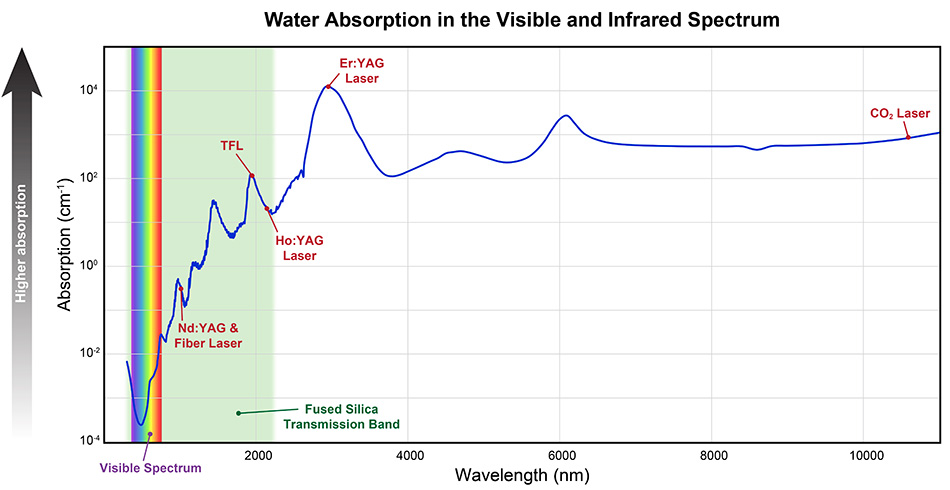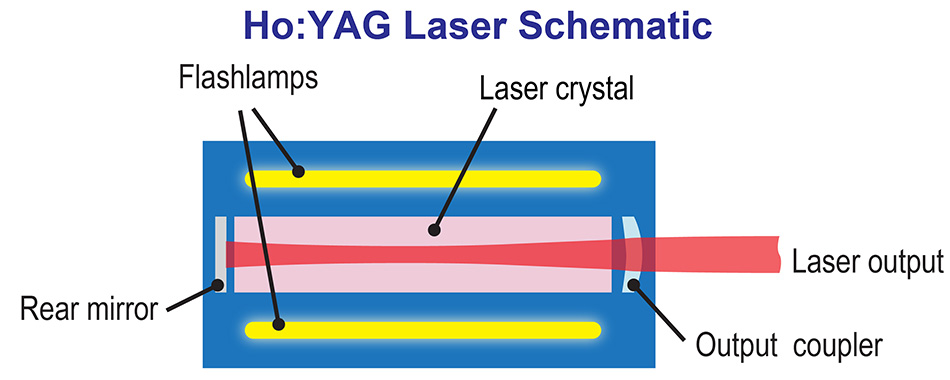What is a Holmium Laser?
The Ho:YAG (or holmium) laser is a high-power, solid-state, near-infrared source that can be fiber delivered. This makes it a popular tool for surgical applications in urology, orthopedics, gynecology, dentistry, and more.
Ho:YAG (holmium) lasers are widely used in surgical applications, and a look at the graph explains why. The graph shows three different things. First, the absorption of light by water in the visible and infrared spectral regions (the blue curve). Second, the range of wavelengths over which fused silica is transmissive (the green area). Finally, the output wavelengths for several different high-power lasers.

All living tissue is essentially water. So, the more that water absorbs a particular laser wavelength, the more efficiently that laser can heat and remove tissue.
Fused silica is the material used to make optical fibers. Lasers with output wavelengths that are transmitted by fused silica can be fiber delivered. This is a highly advantageous surgical modality.
Thus, the ideal laser for fiber-delivered surgical procedures has a wavelength that is well absorbed by water and is also within the fused silica transmission range. Currently, there are really only two lasers that meet these criteria. The holmium laser and the thulium fiber laser (TFL). Water absorption at wavelengths around 1000 nm is relatively low, which makes both Nd:YAG and fiber lasers less useful as surgical sources.
The holmium laser was developed several decades ago and has now become the established source for many medical applications. The TFL actually has more desirable properties than the holmium laser – in terms of output characteristics, practical features, and cost. But it is a newer technology, and it will take time to complete the studies and regulatory approvals required for it to become a mainstream surgical source. Thus, the holmium laser currently reigns supreme.
The longer infrared wavelengths of both Er:YAG (erbium) and CO2 lasers mean they can’t be fiber delivered. This limits the way they can be deployed for surgery, although they are both widely used for medical applications, particularly in dentistry and dermatology.
Ho:YAG laser construction and characteristics
Ho:YAG is the abbreviation for an yttrium aluminum garnet crystal doped with holmium (Ho3+) ions. Ho:YAG can be used to construct solid-state, pulsed lasers with output at 2.1 µm.
There are no common diode lasers which output at the main absorption band in Ho:YAG at 1.9 µm, so these lasers are typically flashlamp pumped. The Ho:YAG laser resonator follows the typical flashlamp-pumped laser configuration, and is shown schematically in the figure. Bursts of light from the flashlamp are focused into the laser crystal. These supply energy and the crystal then produces pulses of laser light.

Ho:YAG lasers are commercially available in (average) output powers ranging from about 20 W to 150 W. Because of the inefficiency of pumping the laser crystal with a broadband (flashlamp) source, these lasers are relatively power hungry and also generate a fair amount of waste heat. As a result, they typically require 230 V power and water cooling.
The pulsing characteristics from a Ho:YAG laser can be varied by changing the way the flashlamp is operated. This provides the surgeon flexibility in controlling exactly the way the laser light interacts with tissue.
This variety of commercially available products, together with the large parameter space over which a given Ho:YAG laser can operate, enables these sources to support a diverse range of medical applications. Because of this, they are often dubbed the “Swiss Army Knife of lasers.” Some of the most important surgical applications of Ho:YAG lasers are outlined here.
Laser lithotripsy
Laser lithotripsy is one of the main applications for Ho:YAG lasers. Here, the laser is used to break up a kidney stone that has become lodged somewhere within the urinary tract. Laser lithotripsy generally provides better outcomes than alternative methods such as shock wave lithotripsy, ureteroscopy, or percutaneous nephrolithotomy (PCNL).
Laser lithotripsy is most commonly implemented in combination with ureteroscopy. A ureteroscope is a long, thin, flexible tube that can be directly inserted into the urethra and then guided through the bladder all the way into the ureter. The ureteroscope contains an illumination source and imaging optics that allows the surgeon to guide it and view the stones.
For lithotripsy, an optical fiber is inserted into the ureteroscope. The Ho:YAG laser is focused into the fiber and delivered to the stone through it. The laser light is absorbed by the stone to break it up.
In lithotripsy, the ability to vary the output parameters (repetition rate, pulse energy, and pulse duration) of the Ho:YAG laser allows the surgeon to employ a variety of methods for stone removal. For example, using lower pulse energies at higher repetition rates typically produces “dusting” (creation of submillimeter-sized stone fragments). Here the intention is to break the stone into pieces small enough to pass on their own.
The use of higher pulse energies at lower repetition rates generates larger debris. In this method, called “fragmentation with extraction” the surgeon then uses a catch basket on the ureteroscope to remove these larger pieces.
Prostate surgery
Benign prostatic hyperplasia (BPH) is the medical term for an enlarged prostate. This can cause irritation and difficulties with urination. About half of all men will have some degree of BPH by the age of 60.
Two widely used surgical treatments for BPH are holmium laser ablation of the prostate (HoLAP) and holmium laser enucleation of the prostate (HoLEP). Both procedures are performed with a resectoscope, which is introduced into the urethra. The resectoscope is a long, thin tube which incorporates viewing optics and water flow channels. It also allows a fiber optic to be inserted to deliver the laser beam to the surgical site.
In HoLAP, the laser is used to ablate tissue and reduce the size of the prostate. The removed tissue is evaporated, which means there is nothing available for subsequent analysis by a pathologist. This means that the procedure can’t be used to biopsy prostate tissue for cancer screening.
In contrast, HoLEP uses a different fiber delivery configuration which enables the surgeon to actually cut larger pieces (enucleate) from the prostate. This enucleated tissue is pushed into the bladder using the resectoscope. At the end of the procedure, those pieces are extracted which allows for subsequent analysis.
Because HoLAP utilizes a smaller penetration depth for the laser energy, removing a given amount of tissue can take more time than with HoLEP. But HoLAP is essentially a bloodless method which delivers excellent results and quicker recovery times. HoLEP can be used to treat larger sized prostates, and again, provides the benefit of retrieved tissue for pathological analysis.
Orthopedics
Ho:YAG laser are used in a number of different orthopedic procedures. Typically, these are performed using arthroscopy. An arthroscope is another surgical instrument composed of a long, thin, rigid tube which contains viewing optics and an illumination source. It can also accommodate the fiber optic to enable laser beam delivery to the surgical site.
The arthroscope is introduced into the body through a small incision. The surgeon locates the area that requires treatment, and typically uses the holmium laser to vaporize tissue and correct the problem. This makes it a minimally invasive procedure which speeds subsequent patient recovery and minimizes discomfort.
One example of this is laser discectomy. Here the procedure is intended to reduce a herniated spinal disc. Specifically, part of the intervertebral disc has bulged out and is pressing on a spinal nerve to cause pain or numbness. The laser is used to directly vaporize the bulged area.
Laser-assisted arthroscopic surgery is also used to treat a variety of conditions on joints, such as knees, ankles, and shoulders. Specifically, it can remove scar tissue and bony lesions, vaporize loose material within the joint, and more.
Coherent is a fully vertically integrated manufacturer of Ho:YAG and other laser crystals. We support holmium medical laser builders with extensive crystal growth capabilities, metrology to consistently minimize absorption, coating facilities, in-house laser damage testing, and production of opto-mechanical assemblies.